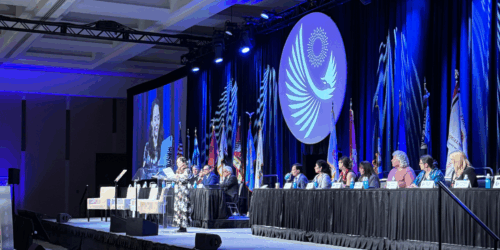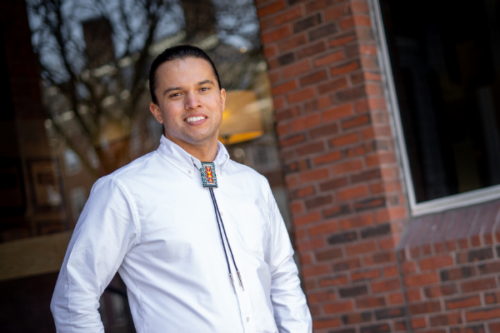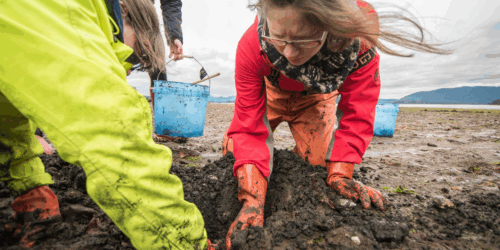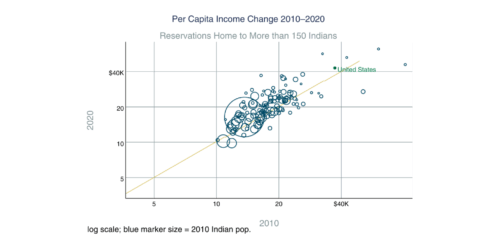In the small city of Ada, Oklahoma, the buildings belonging to the Chickasaw Nation stand out. Ringed with meticulous landscaping, the modern facilities of the Chickasaw Nation reflect the Nation’s economic and community development efforts, which transformed Chickasaw’s tribally-owned businesses into one of the largest private employers in Oklahoma.
“Tribes must be really innovative in how they create revenue to help fund some of their vital social services,” says Joel Chastain MC/MPA 2022, an enrolled citizen of the Chickasaw Nation with Pueblo of Laguna and Navajo Nation heritage, who has worked on a variety of Native economic development initiatives. Chastain explains that tribes, unlike most state and local governments across the United States, face the unique challenge of not being able to levy taxes on the people who live within their boundaries.
After graduating from Haskell Indian Nations University, an all-Native American university in Kansas, with his undergraduate degree in business administration and management, Chastain was hired by the Chickasaw Nation Treasury Department. There, as an accountant, he was responsible for helping manage the finances of a variety of the tribe’s businesses. At the Chickasaw Treasury Department, Chastain saw firsthand how the tribe’s economic development efforts were creating a firm fiscal base for the tribe and growing employment opportunities for Chickasaw Nation citizens and its non-tribal neighbors alike.
Yet for all the Chickasaw Nation’s success with its economic development strategies, Chastain understood that the tribe was an outlier in this regard. “I knew what I was experiencing at the Chickasaw Nation was extraordinary,” reflects Chastain.
“Economic development in Indian Country has been an uneven proposition,” says Megan Minoka Hill, Program Director for the Harvard Project on Economic Development (Harvard Project) at the Ash Center. “While many tribal nations have achieved tremendous success, many others still struggle with building the right environment to create a firmer economic base for their citizens.”
A desire to understand why this economic disparity persists in Indian Country led Chastain to the Harvard Project, its co-director Professor Joe Kalt, and the Project’s extensive body of work examining the conditions under which sustained, self-determined political, social, cultural, and economic strengthening can be achieved by Indigenous communities. “In 2014, I finally built up enough courage to email Joe Kalt and asked if I can audit one of his courses,” recalls Chastain.
A few months later, Chastain was on a plane to Boston joining classmates from around the world for the January-term “Native Americans in the 21st Century: Nation Building” taught by Kalt. That January in Cambridge, Chastain dove into case studies on tribal governance and economic development. By the end of the class, Chastain knew he had to come back to Harvard Kennedy School to learn more. “I think what hooked me on wanting to come to HKS was that they taught the course using a lot of case studies on North America tribal economic development and what tribes are doing, including best practices. But they were teaching it how some of the main principles could be applied to other developing countries.”
Before returning to Cambridge, Chastain was determined to gain additional experience working with Native nations. He spent a year in Washington, D.C. advocating for tribal nations with the National Congress of American Indians as a Wilma Mankiller Fellow before returning to work for the Chickasaw Nation. Back in Oklahoma, he served in several roles for the tribal government’s organizational planning support department, where he helped evaluate new tribal programs and services. When the pandemic hit, Chastain, like so many, began to reflect on his career and goals. He knew then it was time to apply and return to Harvard Kennedy School.
Again, Chastain found himself on a trip to Cambridge, Massachusetts—this time alongside his wife, three kids, and dog.
Chastain was awarded the Ash Center’s Roy and Lila Ash Fellowship, a scholarship for a meritorious mid-career student with a proven dedication to improving democratic governance. “Joel’s record of public service and deep engagement around core democratic principles related to self-determination and governance made him the perfect fit for the Roy and Lila Ash fellowship. We couldn’t have been more pleased to welcome Joel into the Ash community and support his studies at HKS,” says co-executive director of the Ash Center Tim Glynn-Burke.
Arriving on campus, Chastain set out to build and refine analytic and policy skills that he could bring back to the Chickasaw Nation. “I wanted to be able to go back to my tribe with a few different tools in my tool belt,” he says. He took courses on measuring social impact, digital government, and returned to Kalt’s class to get credit for the course he once visited.
He also participated in Adjunct Lecturer in Public Policy Eric Henson’s “Nation Building 2” course. Leaning on his own experience and the skills learned in “Nation Building 1,” Chastain worked with the New Mexico Secretary of Indian Affairs Office to help incorporate tribal governments in New Mexico into the state’s climate action plan. Back on campus, Chastain also helped resurrect the Native and Indigenous Caucus at Harvard Kennedy School, a community for Harvard students interested in tribal affairs.
As he considers his future, it is clear to Chastain there is plenty of tribal advocacy work to be done. He sees himself returning to work again for the Chickasaw Nation, continuing his passion for public service and tribal advocacy. First, however, he plans to continue his academic journey. In the fall, Chastain will start at the MIT Sloan School of Management pursuing his Master of Business Administration.
As he continues with his studies and work with Native nations, Chastain hopes that other tribal students and youth see opportunity in his path. “I hope I can inspire more Native Americans that have either come from a tribal college or worked in their tribal community to dream big as well.”
Written by Sarah Grucza, Assistant Director of Communications




